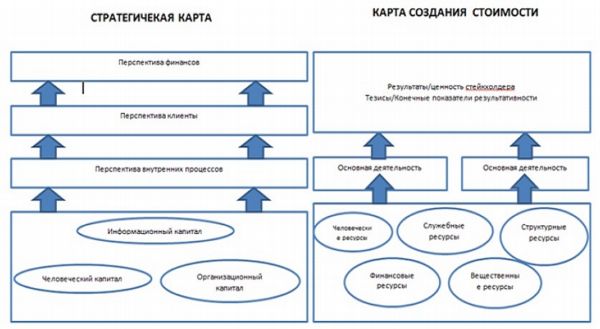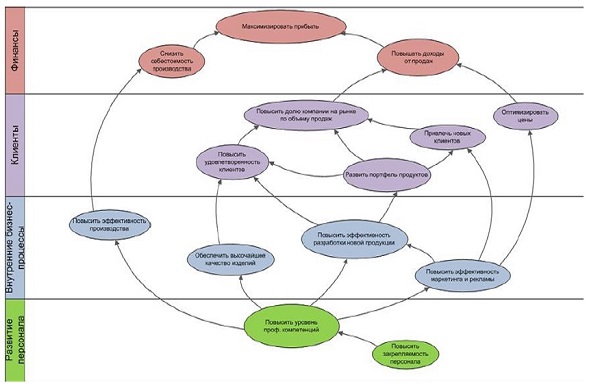strategic map
The strategy map is a fundamental component of the balanced scorecard.
How to develop a strategy map?
1. The strategy map displays the key goals that ensure the successful implementation of the strategy. The main function of the map is the cause-and-effect mapping of goals in the process of implementing the strategy.
2. Scorecard describes metrics - measures used to track progress towards goals; target values of indicators, strategic initiatives chosen to stimulate activities to achieve strategic goals.
Figure 1 shows a strategy map and a value creation map. Both techniques are successfully used by companies around the world.

Transferring strategy to visual maps is one of the most powerful management tools today. The main advantage of this tool is the presentation on one sheet of all goals for key prospects as a single mechanism for implementing the strategy.
Practice shows that creating a correct map makes it easy to identify key performance issues, key performance indicators and strategic initiatives. If the SC is created incorrectly, the scorecard will also be incorrect.
Achieving clarity and coherence in strategic goals is one of the most important tasks of management, and the most productive way to achieve coherence in goals is the creation of a strategic map by a well-coordinated management team. Such a map will direct the company's resources in the right direction.
Pitfalls of developing a strategic map
Despite the apparent advantages, companies constantly make fundamental mistakes when creating the SC. The construction of a strategic map, despite its apparent simplicity, hides a number of difficulties that need to be clarified.
An important starting point in the creation of the SC is a meaningful vision and formulation of the mission or goal of the top level. Unfortunately, most of the language is pretty standard and boring, such as "be number 1 for our customers." As a contrasting example, other formulations of the goals can be given: “to be recognized as an “incubator” for nurturing creative, world-changing ideas that will change the reputation and business of our clients.” The mission translates the value proposition to customers, inspires existing and potential employees.
An important stage in the creation of the IC is individual interviews with a team of top managers, conducted by an expert facilitator. It is very important that the management team be involved in the creation of the UK. The facilitator should, among other things, evaluate proposals, share insights and knowledge of good practices. The facilitator must be politically neutral and have the authority to question the leadership team's vision.
The most common fatal error in strategy development is to delegate the creation of the QC to a middle management team or an external consultant, providing only consultations with the management on the results of the work.
How to talk about strategy?
Personal interviews conducted with key personnel at the start of development are recorded in an anonymous format. This condition helps to obtain maximum information for further work.
The following questions can be used to identify strategic vision:
● Why does the organization exist? What is its main purpose? What are you doing and for whom? What is your value proposition?
● What do you need to be good at? What do you need to stand out in order to convey your value proposition to customers? What are your core competencies and key functions as an organization?
● What are the key drivers of activity? What are the key resources you have or need as an organization? What can you say about the employees, their skills and knowledge? your infrastructure? Tell us about your brand, image, patents, organizational culture, your processes and practices?
Along with ascertaining the views of key leaders, defining key goals, it is also important to take into account existing strategy documents, plans, analyzes, etc. This is necessary in order to double-check the accuracy of the strategy and identify errors. The external facilitator should do this during or before the interview.
Based on interview data and information from the strategy papers, the external facilitator can independently construct a strategy map and present it to management for active discussion and collaborative design. The goal of working together is to reach consensus on strategic orientations and the driving forces leading to them. Note that it is extremely important to involve the leadership in this process. The session is a powerful tool for agreeing on strategic priorities without looking at them through the lens of functional areas.
At this stage, the role and skill of the facilitator should not be underestimated. Although the results of the interview should remain the main material for design, the map formed by the facilitator should not be imposed on the leadership team.
Given the level of engagement and changes made, it often makes sense to schedule a follow-up meeting to approve the final map. The second appointment should be scheduled 2 weeks after the first. This allows all changes to be processed and the map to be sent out to participants for local discussion and "reality comparison". Sometimes it makes sense to hold focus group meetings with stakeholders and employees to get feedback on the working version of the map and use this information in a session with top managers.
More doesn't mean better
In addition to the structure of the map, special attention should be paid to its content. A common mistake in filling out a map is to include multiple goals that actually describe everything the organization does. Maps of 30, 40 or even 50 targets are unfortunately not uncommon. Such overloaded maps can rather be called organizational or operational, but in no way strategic. Strategy involves selection and prioritization. In addition, the bulky map is difficult to handle and quickly becomes a real management tool.
The main rule is that the IC should include a very limited number of the most important commercial and non-commercial goals that together will ensure the success of the company. The main thing here is an extremely limited number. Strategic maps of large companies contain up to 20 goals.
As mentioned above, the greatest strength of the strategy map is the visualization of the cause-and-effect relationship - the chain of achievement of the top-level goal becomes clear and understandable. As a rule, the causal relationship on the map is written from the bottom up. At the same time, there are often horizontal links within the same perspective.
When creating a CS, you should also make sure that the diagram clearly conveys the importance of the features on the map. Sometimes it makes sense to draw blocks of different sizes on the SC to emphasize their different importance. For example, if an organization spends 80% of its time and budget on one goal (for example, in the police it is the capture of criminals) and only 20% on another (improvement of administrative work), then it is advisable to depict the first goal in a larger figure. The goal is to create a picture of strategic goals that includes everything important, but at the same time not overloaded. The different sizes of the figures will contribute to this, making the map more readable, demonstrating that, with an overall balance, some goals are “more equal than others” (see Fig. 2).

Rice. 2. An example of a strategic map of a manufacturing enterprise
The name of the target on the map, for simplicity, includes only a short position. At the same time, it is important that the goals have a more detailed description. For example, the goal for the SC is “Develop close interaction and effective management of relationships with stakeholders”. In addition to the short statement, there is a broader description of the goal: “We need to develop close relationships with our clients and make sure we manage relationships with key stakeholders. In addition to our customers, we need to influence broader policy, be the voice of our industry. This means using professional alliances to make sure we are heard. For this, our proactive engagement with customers and stakeholders is vital.”
New ideas in instrument development
The modern direction of development of the middle class is the use of strategic themes. It is popular today to group related goals into 4-5 strategic themes. This simplifies the processes of planning by goals, allowing you to operate with the relationships of blocks - topics. The goals of various topics can be highlighted in color on a strategic map. Responsible leaders can be identified for each topic, while for each goal a responsible person is also identified within, reporting to those responsible for the topic. The system of responsible persons provides direct control over the achievement of each goal. After building a system of work on goals, it is important to control that activities on topics and goals do not turn into isolated actions. To do this, it is important that the working groups are multifunctional, and that the top management team maintains a bird's-eye view. strategic activities.
Dictionary type:
- Human Resources Dictionary
- Leadership, Management, Company management
 Discounted payback period
Discounted payback period Methodological aspects of project management
Methodological aspects of project management Scrum Development Methodology
Scrum Development Methodology